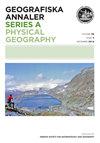Hydroclimate changes over Sweden in the twentieth and twenty-first centuries: a millennium perspective
IF 1.8
4区 地球科学
Q3 GEOGRAPHY, PHYSICAL
Geografiska Annaler Series A-Physical Geography
Pub Date : 2020-11-17
DOI:10.1080/04353676.2020.1841410
引用次数: 13
Abstract
ABSTRACT Climate change poses additional risks for natural and human systems including the hydrological cycle, leading to altered temporal and spatial variation of hydroclimatic conditions. This work assessed the current understanding of the dryness and wetness conditions in Sweden over the last two millenniums based on proxy and instrumental data, as well as climate model simulations and projections until the end of the twenty-first century. The assessment represents a summary of the existing literature concerning analysis of four selected indices for dry/wet conditions relating to precipitation, potential evapotranspiration (PET), and soil moisture (SPEI, PDSI [including scPDSI], SPI, and AI). SPEI considers both precipitation and PET and can show hydroclimatic conditions at different time scales. Therefore, it was chosen to summarize the past and future changes. A focus is put on dry conditions, as drought has strong influences on groundwater which is an important freshwater resource for Sweden. The millennium historical perspective reveals that the current climate is relatively wet and the future would become even wetter as a general wetting trend started some 120 years ago. However, there have been and will be large variations of both dry and wet conditions on short time scales, especially on decadal and interannual time scales. Further, the changes since the 1950s show a regional pattern with most significant wetting in the north, a slightly overall wetting in the south but a drying in central-eastern part including the island of Gotland since 1981. This pattern is broadly consistent with climate model projections for the future.20世纪和21世纪瑞典水文气候变化:千年视角
气候变化给包括水文循环在内的自然系统和人类系统带来了额外的风险,导致水文气候条件的时空变化。这项工作基于代理和仪器数据,以及气候模式模拟和预测,评估了目前对瑞典过去两千年来干旱和湿润状况的认识,直至21世纪末。该评估是对现有文献的总结,涉及与降水、潜在蒸散发(PET)和土壤湿度(SPEI、PDSI[包括scPDSI]、SPI和AI)有关的四个选定的干湿条件指数的分析。SPEI同时考虑降水和PET,可以显示不同时间尺度的水文气候条件。因此,选择它来总结过去和未来的变化。重点放在干旱条件上,因为干旱对作为瑞典重要淡水资源的地下水有强烈影响。从千年历史的角度来看,目前的气候相对湿润,未来将变得更加湿润,因为大约120年前开始出现普遍的湿润趋势。然而,在短时间尺度上,特别是在年代际和年际尺度上,干湿条件已经并且将会有很大的变化。此外,自20世纪50年代以来的变化显示出一种区域模式,即北部最显著的湿润,南部总体上略有湿润,但自1981年以来,包括哥特兰岛在内的中东部地区干旱。这一模式与气候模式对未来的预测大体一致。
本文章由计算机程序翻译,如有差异,请以英文原文为准。
求助全文
约1分钟内获得全文
求助全文
来源期刊
CiteScore
3.60
自引率
0.00%
发文量
12
审稿时长
>12 weeks
期刊介绍:
Geografiska Annaler: Series A, Physical Geography publishes original research in the field of Physical Geography with special emphasis on cold regions/high latitude, high altitude processes, landforms and environmental change, past, present and future.
The journal primarily promotes dissemination of regular research by publishing research-based articles. The journal also publishes thematic issues where collections of articles around a specific themes are gathered. Such themes are determined by the Editors upon request. Finally the journal wishes to promote knowledge and understanding of topics in Physical Geography, their origin, development and current standing through invited review articles.

 求助内容:
求助内容: 应助结果提醒方式:
应助结果提醒方式:


